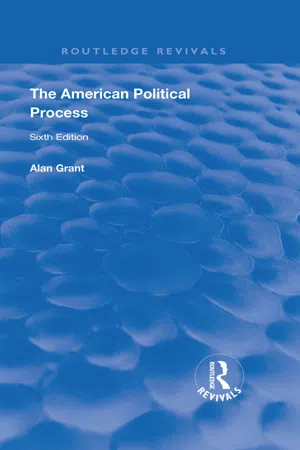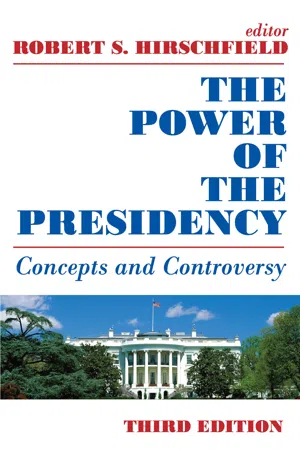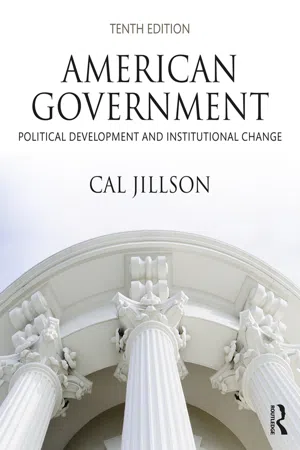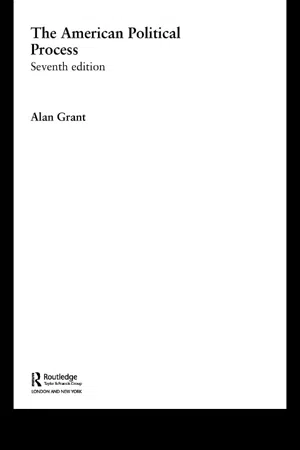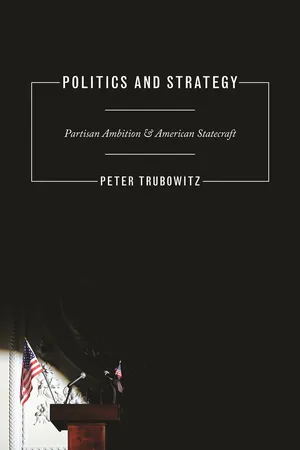Politics & International Relations
Expansion of Presidential Power
The expansion of presidential power refers to the increase in authority and influence wielded by the President of the United States over time. This expansion has been driven by factors such as changes in public opinion, shifts in the balance of power between branches of government, and responses to national crises. It has led to debates about the appropriate limits and checks on presidential authority.
Written by Perlego with AI-assistance
Related key terms
Related key terms
1 of 4
Related key terms
1 of 3
5 Key excerpts on "Expansion of Presidential Power"
- eBook - ePub
- Alan Grant(Author)
- 2019(Publication Date)
- Routledge(Publisher)
Each new President who takes office finds a period of optimism and good will on behalf of the public and the media. However, in the past public expectations have often been too great and hopes have been disappointed, with the consequent erosion of popular support. Dimensions of Presidential Power Many Americans realized for the first time in 1974 the tremendous accretion of power in the hands of the President. The separation of powers principle was incorporated within the Constitution to prevent a concentration of power in one part of the government. The Watergate scandal and the revelations of abuses of power by the executive branch reminded the nation of the message spelt out at Philadelphia. A system that places the responsibilities we have described in the hands of one man must offer temptations for abuse. Arthur Schlesinger Jr has argued that the concept of the constitutional Presidency had given way by the 1970s to an ‘Imperial Presidency’—a revolutionary use of power quite different from that envisaged by the Founding Fathers. 20 However, it would be a serious error to assume that the growth of executive power happened suddenly during Richard Nixon’s administration; the history of the executive branch has been one of aggrandizement as people have turned to Presidential initiatives to get things done, and the President has filled the power vacuum left by the inertia or inaction of Congress, the states, or private enterprise. The growth of the Presidency has not been at a consistent pace—there were reactions to Lincoln’s temporary autocracy and to governmental control in World War I. The major expansion has undoubtedly taken place since the 1930s and the excesses of the Nixon Presidency came as a culmination of forty years of executive development - eBook - ePub
The Power of the Presidency
Concepts and Controversy
- Robert S. Hirschfield(Author)
- 2017(Publication Date)
- Routledge(Publisher)
varies , with any President’s capacity to influence or control the course of national or international affairs being dependent at any given time on five major factors: 1) the meaning currently attributed to the formal, constitutional sources of executive authority; 2) the state of the political system in which the specific Presidency is operating; 3) the personal attributes and attitudes of the incumbent President; 4) the particular set of circumstances, conditions, and events presently confronting the nation; 5) the popularity of the incumbent President and the degree to which he enjoys the public’s trust and confidence. All of these factors change from time to time and from President to President. They are constantly in flux, and since the power of the Presidency is the product of interaction among all of them, the dimensions of that power are continually changing. As a result, no absolute definition of presidential power is possible, because that power is always in the process of being defined.Presidential Power and the Constitutional System
When Professor Woodrow Wilson said “the President is at liberty, both in law and conscience, to be as big a man as he can,” he indicated the range of possibilities open to a President in attempting to exercise power and emphasized that the essential attribute of the constitutional office is its flexibility. For the Presidency under the Constitution is only potentially, not necessarily, powerful. That document’s executive provisions, even more than the others, are general, indefinite, and ambiguous. The basic characteristics of the office—its unitary form, independent functions, and national purview—are clear enough. But Article II provides at best only a hint of the Presidency’s potential for power. In fact, those cryptic provisions raise more questions than they answer. The President is “commander-in-chief of the army and the navy of the United States.” But does this make him only the nation’s “first general and admiral,” as Hamilton insisted, or does it empower him to use the armed forces in such a way as to commit the nation to war? Does his authority to make treaties by and with the advice and consent of two thirds of the Senate require a sharing of power in the formulation and control of foreign policy, or does it mean, as the Supreme Court once stated, that the President is America’s “sole organ of government” in the field of international relations? The President is to “take care that the laws be faithfully executed,” but faithful according to what standard? Congressional intention? Judicial rulings? His own determination of constitutionality or political expediency? The very first words of Article II read: “The Executive power shall be vested in a President of the United States of America.” But is this simply an introductory statement, or is it a grant of inherent power to act in any way the President deems necessary to protect the national interest? - eBook - ePub
American Government
Political Development and Institutional Change
- Cal Jillson(Author)
- 2019(Publication Date)
- Routledge(Publisher)
Constitutional authority and political resources are shared by the president, Congress, and the courts. 2 The resulting dilemma has been nicely stated by Stephen Skowronek. In describing the mismatch between popular understanding of the president in the American political system and the office’s constitutional authority, Skowronek wrote, “Formally, there is no central authority. Governing responsibilities are shared, and assertions of power are contentious. Practically, however, it is the presidency that stands out as the chief point of reference . . . it is the executive office that focuses the eyes and draws out the attachments of the people.” 3 Article II of the Constitution outlines the powers of the presidency and its relationships to the other branches only in broad terms. Edward S. Corwin, the leading mid-twentieth-century student of the presidency, warned that the Constitution’s broad language concerning the war powers (Congress declares war, the president is commander in chief) was “an invitation to struggle.” 4 The Constitution, law, and precedent provide broad parameters to presidential power. Ultimately, within these parameters, each president defines a way of being president and acting in the office that works for him and that others, in government and out, recognize and accept. George Bush and Dick Cheney, convinced that presidents weakened by Vietnam and Watergate had allowed Congress and the courts to encroach upon the executive’s rightful prerogatives, were determined to restore them. During Bush’s first term, and especially after 9/11, the administration advocated the unitary executive theory of presidential power. The unitary executive theory, discussed above, holds that executive branch authority resides in the president and that, especially in wartime, the president, in his role as commander in chief, is the sole judge of what is required to protect the American people - eBook - ePub
- Alan Grant(Author)
- 2003(Publication Date)
- Routledge(Publisher)
Bush’s poll ratings continued to remain high during 2002 with 60 per cent or more regularly approving of his performance in office. After an initially hesitant start the crisis seemed to give Bush a new belief in himself and he appeared to most Americans to be a strong and courageous leader when the country needed one. Politically, the events of ‘9/11’ provided the Democrats with a dilemma as to how far to oppose a popular President, particularly on national security and foreign policy issues. The Democrats were split on whether to support Bush’s policy in relation to Iraq, a factor which harmed the party in the 2002 midterm elections when the President used his public support to help Republican candidates to regain control of both houses of Congress. Dimensions of presidential power Many Americans realised for the first time in 1974 the tremendous accretion of power in the hands of the President. The separation of powers principle was incorporated within the Constitution to prevent a concentration of power in one part of the government. The Watergate scandal and the revelations of abuses of power by the executive branch reminded the nation of the message spelt out at Philadelphia. A system that places the responsibilities we have described in the hands of one man must offer temptations for abuse. Arthur Schlesinger Jr argued that the concept of the constitutional presidency had given way by the 1970s to an ‘Imperial Presidency’ – a revolutionary use of power quite different from that envisaged by the Founding Fathers. 24 However, it would be a serious error to assume that the growth of executive power happened suddenly during Richard Nixon’s administration. The history of the executive branch has been one of aggrandisement as people have turned to presidential initiatives to get things done, and the President has filled the power vacuum left by the inertia or inaction of Congress, the states, or private enterprise - eBook - ePub
Princeton Studies in International History and Politics
Partisan Ambition and American Statecraft
- Peter Trubowitz(Author)
- 2011(Publication Date)
- Princeton University Press(Publisher)
CHAPTER FOUR When States Expand W HY DO STATES SEEK TO EXPAND their political influence abroad? Realists of various persuasions argue that the explanation lies in the international system and the uncertainty its anarchical structure creates for statesmen. As a state’s power (meaning its material resources) relative to that of other nations increases, so will its desire to extend its political influence and control internationally—to do what it can, militarily, economically, and diplomatically to enhance its security in an uncertain world (Krasner, 1978; Gilpin, 1981; Zakaria, 1998). Robert Gilpin (1981, 94) calls this the “realist law of uneven growth” and argues that it is the central dynamic of international politics. In order to increase their own security, growing states will actively seek to change their international environment in ways that will offer them greater political, economic, and territorial control. In the realist model, expansionism has little to do with leaders’ own political ambitions, or with the interests of their partisans. Leaders expand abroad because they can and when they can, not when it pays domestically for them to do so. T HEORIES OF E XPANSIONISM In this chapter, I argue that foreign ambition cannot be easily divorced from leaders’ political self-interest. Expansionist foreign policies aim at extending a nation’s geopolitical reach and political control beyond its borders. These efforts can take the classic form of imperial conquest and subjugation of foreign peoples, but there are also other, less formal methods of expansion. Leaders can create protectorates, annex contiguous territories, build military bases, or establish spheres of influence. I argue that leaders are mostly likely to pursue such expansionist goals when they enjoy geopolitical slack and when expansionism pays domestically. I show that increased military power does give leaders greater flexibility or latitude in deciding where and how to use that power
Index pages curate the most relevant extracts from our library of academic textbooks. They’ve been created using an in-house natural language model (NLM), each adding context and meaning to key research topics.
Explore more topic indexes
Explore more topic indexes
1 of 6
Explore more topic indexes
1 of 4
